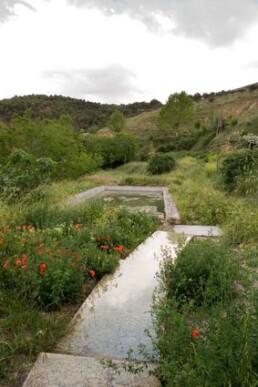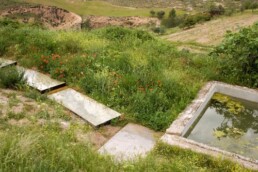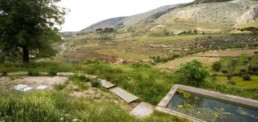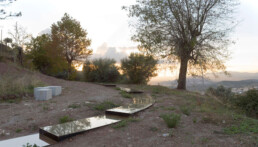Intervention in the landscape in the Cortijo de las Colonias by Carmen Moreno
DATE
05.04.2024
The Granada architect Carmen Moreno, who will be at MArch on April 15, is the author of a significant project located in Víznar, north of Granada.
The Cortijo de las Colonias estate, located on the road to the Fuente Grande de Víznar spring, is part of the stepped landscape of the ravine through which the Aynadamar irrigation canal runs, vital for the water supply of the Albaicín neighborhood in Granada since Arab times. . However, its history takes on a grim relevance due to its use during the civil war as the last prison for those condemned to death, including the poet Federico García Lorca.
The project seeks to intertwine architecture, landscape, history and archaeology, using as materials the remains of the old mill, the agricultural production of the terraces, water and symbolism. Recovering the memory of the place, three routes are designed: the walker’s path, which unfolds next to the recovered irrigation ditch; the water path, which incorporates pools and stops to discover the landscape; and the transparent path, which symbolizes the last walk of Lorca and others, culminating in water and poetry carved in stone. This path evokes the last walk of the great Granada poet and others, imposed before his tragic death. It is the symbolic representation of his lives as an unfinished journey, culminating in poetry, his eternal legacy. A transparent path, barely perceptible between the earth and the shine of the water, that only a few will discover among the undergrowth.
The intervention proposal on this site is an infrastructure in the landscape, an evocation of events, a map of routes, a tribute. It involves the archaeological recovery of lost elements, a heritage action. The project in Víznar is difficult to categorize; It is not limited to architecture or traditional public space, but rather encompasses the field of landscape and art from a heritage perspective. It is a way of approaching the place and its internal history, through an interpretive and recording look that redefines the map of the territory and works on the landscape in a different way, exploring its memory. It operates through a complex system of found relationships, identifying components and organizing them to transform the place, interacting with past events and elements that have shaped its landscape over time.
MArch Valencia. Arquitectura y Diseño
© 2022 MArch Valencia. Arquitectura y Diseño
Privacy policy | Cookies policy | Terms of use



